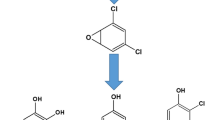Abstract
The present study investigated the toxicokinetics of 1,4-dioxane in humans exposed at rest and during physical stress. Eighteen volunteers were divided into three groups of six individuals each, who were exposed separately in three experiments to 20 ppm (73 mg/m3) 1,4-dioxane for 8 h. The first group was exposed at rest (Experiment 1), whereas the other groups performed exercises on a bicycle ergometer for 10 min every hour, corresponding to a physical exercise of 50 W (Experiment 2) and 75 W (Experiment 3), respectively. Blood samples were collected after 4 and 8 h, and all urine samples were collected over 24 h. The samples were analysed for 1,4-dioxane and its metabolite 2-(2-hydroxyethoxy)acetic acid (HEAA). The amount of urinary-eliminated HEAA increased during exposure and showed its maximum 9.8 ± 1.9 h after the beginning of exposure. The levels of 1,4-dioxane in blood and urine, however, barely rose above the limit of detection. Depending on the physical stress of the volunteers, the maximum elimination rate of HEAA in urine was significantly increased with 23.2 ± 7.7, 30.4 ± 7.2 and 41.8 ± 23.8 mg/h for Experiments 1, 2 and 3, respectively. Likewise, the cumulative HEAA excretion over 24 h increased with increasing physical stress; 53 ± 15 % of the theoretical inhaled 1,4-dioxane dose was excreted as HEAA in urine during the first 24 h. The average maximum level of HEAA ranged between 378 and 451 mg/g creatinine and increased with the applied physical stress. The half-life of HEAA was found to be 3.4 ± 0.5 h. Twenty-four hours after the beginning of the exposure, 31–51 mg HEAA/g creatinine were still detected in urine, indicating only a low accumulation of the metabolite during a working week. The study results revealed an increasing effect of the applied physical stress on the total eliminated amounts of HEAA as well as on the maximum HEAA levels at the end of exposure. For the estimation of biomonitoring equivalents to occupational exposure limits, this effect should be taken into account.




Similar content being viewed by others
References
ACGIH-American Conference of Governmental Industrial Hygienists (2014) Threshold limzit values for chemical substances and physical agents & biological exposure indices 2014. ACGIH, Cincinnati
Bader M, Messerer P, Will W (2013) Urinary creatinine concentrations in an industrial workforce and comparison with reference values of the general population. Int Arch Occup Environ Health 86:673–680. doi:10.1007/s00420-012-0802-4
Blaszkewicz M, Angerer J, Working group analyses in biological materials (2013) Tetrahydrofuran (THF) in urine (addendum to the DFG method “Alcohols and Ketones”). In: Göen T, Harwig A (eds) The MAK-collection for occupational health and safety. Part IV: biomonitoring methods, vol 13. Deutsche Forschungsgemeinschaft, Wiley-VCH, Weinheim, pp 265–276. doi:10.1002/3527600418.bi10999e0013
Braun WH, Young JD (1977) Identification of ß-hydroxyethoxyacetic acid as the major urinary metabolite of 1,4-dioxane in the rat. Toxicol Appl 39:33–38
Csanády GA, Filser JG (2001) The relevance of physical activity for the kinetics of inhaled gaseous substances. Arch Toxicol 74:663–672. doi:10.1007/s002040000158
Deutsche Forschungsgemeinschaft (DFG) (2014) List of MAK and BAT values 2014. Commission for the investigation of health hazards of chemical compounds in the work area. Report no 50. Wiley-VCH, Weinheim. doi: 10.1002/9783527682010.oth2
Eckert E, Gries W, Göen T, Leng G (2013) Reliable quantification of ß-hydroxyethoxyacetic acid in human urine by an isotope-dilution GC–MS procedure. J Chromatogr B 935:80–84. doi:10.1016/j.jchromb.2013.07.017
Greim H (ed) (2000) The relevance of physical activity for inhalation kinetics. In: Occupational toxicants: critical data evaluation for MAK values and classification for carcinogens, vol 14. Deutsche Forschungsgemeinschaft, Wiley-VCH, Weinheim, pp 3–10. doi:10.1002/3527600418.mb0akintkie0014
Greim H (ed) (2004) 1,4-Dioxane. In: Occupational toxicants: critical data evaluation for MAK values and classification for carcinogens, vol 20. Deutsche Forschungsgemeinschaft, Wiley-VCH, Weinheim, pp 106–133. doi:10.1002/3527600418.mb12391e0020
IARC-International Agency for Research on Cancer (1999) 1,4-Dioxane. In: IARC mongraphs on the evaluation of carcinogenic risks to humans. Re-evaluation of some organic chemicals: hydrazine and hydrogen peroxide, vol 71. WHO, Geneva, pp 589
Jakubowski M, Czerczak S (2009) Calculating the retention of volatile organic compounds in the lung on the basis of their physicochemical properties. Environ Toxicol Pharmacol 28:311–315. doi:10.1016/j.etap.2009.05.011
Knecht U, Südmeyer L, Woitowitz HJ (1999) The influence of physical activity on the conception of MAK-BAT values. Eur J Oncol 4:599–602
Larsen K (1972) Creatinine assay by a reaction-kinetic principle. Clin Chim Acta 41:209–217
Mörk AK, Johanson G (2006) A human physiological model describing acetone kinetics in blood and breath during various levels of physical exercise. Toxicol Lett 164:6–15. doi:10.1016/j.toxlet.2005.11.005
Reitz RH, McCroskey PS, Park CN, Andersen ME, Gargas ML (1990) Development of a physiologically based pharmacokinetic model for risk assessment with 1,4-dioxane. Toxicol Appl Pharmacol 105:37–54
SCOEL (2004) Recommendation from the scientific committee on occupational exposure limits for 1,4-dioxane. SCOE/SUM/112. European Commission, Brussels
Wigaeus E, Holm S, Åstrand I (1981) Exposure to acetone: uptake and elimination in man. Scand J Work Environ Health 7:84–94
Woo YT, Argis MF, Arcos JC, Griffin GW, Nishiyama K (1977) Structural identification of p-dioxane-2-one as the major urinary metabolite of p-dioxane. Naunyn-Schmiedeberg´s Arch Pharmacol 299:283–287
Young JD, Braun WH, Rampy LW, Chenowth MB, Blau GE (1976) 1,4-dioxane and beta-hydroxyethoxyacetic acid excretion in urine of humans exposed to dioxane vapors. Toxicol Appl Pharmacol 38:643–646
Young JD, Braun WH, Rampy LW, Chenowth MB, Blau GE (1977) Pharmacokinetics of 1,4-dioxane in humans. J Toxicol Environ Health 3:507–520
Young JD, Braun WH, Gehring PJ (1978) Dose-dependent fate of 1,4-dioxane in rats. J Toxicol Environ Health 4:709–726
Acknowledgments
The authors are grateful to all volunteers who participated in the study. The authors are indebted to Johannes Müller who performed the analysis of the air sampling, Claudia Ferstl for her technical assistance in the HEAA analysis and Michaela Förster for proofreading of the manuscript.
Author information
Authors and Affiliations
Corresponding author
Ethics declarations
Conflict of interest
The authors declare no conflict of interest.
Rights and permissions
About this article
Cite this article
Göen, T., von Helden, F., Eckert, E. et al. Metabolism and toxicokinetics of 1,4-dioxane in humans after inhalational exposure at rest and under physical stress. Arch Toxicol 90, 1315–1324 (2016). https://doi.org/10.1007/s00204-015-1567-9
Received:
Accepted:
Published:
Issue Date:
DOI: https://doi.org/10.1007/s00204-015-1567-9




